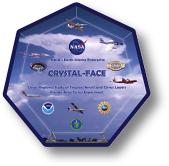 |
CRYSTAL-FACE
Overview
The interaction of clouds with the rest of the Earth's climate system poses a major uncertainty in understanding and predicting global climate change. It is the objective of the CRYSTAL-FACE program to better understand the physical properties of tropical cirrus clouds and their formative processes. ETL is deploying the NOAA Portable Cloud Observatory to the Miami, Florida area, to provide detailed profiles of the physical properties of clouds during the July experiment.
Field Phase
Scientists from the Environmental Technology Laboratory (ETL), along with scientists from numerous other government agencies and universities, will meet in southern Florida during the month of July to participate in this year's Cirrus Regional Study of Tropical Anvils and Cirrus Layers (CRYSTAL)-Florida Area Cirrus Experiment (FACE). CRYSTAL-FACE is the latest experiment in NASA's First ISCCP Regional Experiment (FIRE) program, which began in the mid-1980's. ETL has been a long-term participant in the FIRE program, whose aim is to improve our understanding of fundamental processes involving clouds and radiation and their role in the world's changing climate system.
In addition to extensive flight operations based in Key West Florida, CRYSTAL-FACE will have two areas of ground operations: one in the Miami area and the other on the west coast of Florida near Everglades City. Scientists from ETL will deploy the NOAA Portable Cloud Observatory (NPCO) to the Miami site to provide continuous, high-resolution profiles of cloud boundaries, characteristic particle sizes and water contents of both liquid and ice clouds. This information will then be input into detailed radiation transfer models to assess the radiative impact of these clouds.
NOAA Portable Cloud Observatory
The NPCO employs a millimeter-wave, cloud-profiling radar (MMCR), a 3-channel (21 GHz, 31 GHz, and 90 GHz) microwave radiometer that measures the total amount of liquid condensate and water vapor above the site, an infrared thermometer, and surface meteorological measurements. Near real-time images of these measurements, and the profiles of cloud properties derived from them, will be placed on ETL's web site during the experiment.
Relevance to NOAA
The focus of CRYSTAL-FACE is to explore the physical properties of tropical cirrus clouds and their formation processes. Of particular interest to scientists is the role of cirrus clouds in the hydrologic and radiative processes in the upper troposphere and lower stratosphere. The answers gained from ETL's participation in CRYSTAL-FACE will greatly help NOAA's climate program in its ongoing efforts to understand the complex role clouds play in regulating the Earth's weather and climate. The data collected will also be a valuable resource for the verification of NOAA products derived from satellites and numerical weather prediction models.